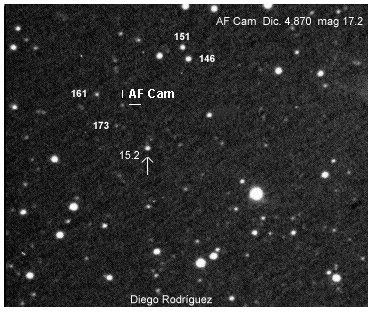
















adolfodarriba@
observatoriolascasqueras.es



Indeed, it lacked a star of magnitude 15.2 indicated with an arrow to 47 seconds from arc to the East and 83 seconds of arc to the North of the variable, as Rodriguez with the magnitudes taken from the AAVSO is appraised in this image of Diego.

Once corroborated the absence by other members of the M1 Group, I sent an electronic mail to the AAVSO day 29 of November of the 2002.
In this one case, one is a mistake, since the star that lacks falls completely within the magnitude limit of the chart.
As I have a Celestron SP-C8 of 203 mm, it needed very dark nights to verify such finding. Even so, by those days I did just like in the chart of AO Tau, to be generated an image in DSS to be totally safe that it was there and in addition, that not outside variable, when being of equal brightness in the two images.
Until the day of the last bring up to date it continues being the chart without rectifying. If in the chart of the variable AO Tau at the moment have not rectified it with the serious made error, I denounce that the chart of the AF Cam will take in modernizing it.
Comment Marc Biesmans:
According to the chart in CCD(V) of Arne Henden, this star is of the magnitude 16,472 = 16,5 but with an extremely high B-V the 2,79 for what is an extremely red star.
Comment Mike Simonsen:
To the being an extremely red and very weak star that falls outside of the threshold of the chart of the AAVSO, doesn't have thought of a principle to rectify the chart.
My last comment:
To the being a weak star of the magnitude 16,5 has not included it in the chart of the AAVSO, but for the effect Purkinje, the human eye observes the most brilliant red stars and it seems this way that visually a star is observed but in the field, entering in the threshold of the chart . For all that said, I believe that it would be necessary to include it, since so much in visual as in CCD, a new star would be observed in the chart of the AAVSO, like leave clearly in the image of up.

|

|